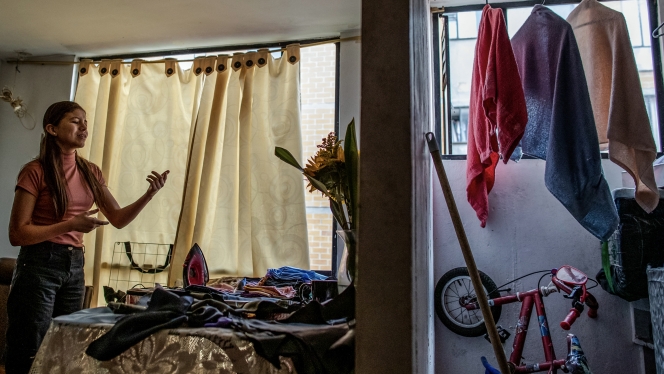Gerhard Richter, Abstraktes Bild (Tableau abstrait), 2005
Gerhard Richter, Abstraktes Bild (Tableau abstrait), 2005
Oil bottle decorated with peonies and chrysanthemums, Goryeo dynasty (918–1392), 13th century
Oil bottle decorated with peonies and chrysanthemums, Goryeo dynasty (918–1392), 13th century. Stoneware with copper-red and inlaid design under celadon glaze. H. 2 1/2 in. (6.4 cm); Diam. 3 1/8 in. (7.9 cm). The Metropolitan Museum of Art, Gift of Sadajiro Yamanaka, 1911, 11.8.3. © 2000–2017 The Metropolitan Museum of Art
Small jar and cover decorated with chrysanthemums, cranes, and clouds, Goryeo dynasty (918–1392), late 13th century
Large jar with peony decoration, Joseon dynasty (1392–1910), late 15th century
Large jar with peony decoration, Joseon dynasty (1392–1910), late 15th century. Buncheong ware with incised and sgraffito design. H. 15 in. (38.1 cm); Diam. 10 7/8 in. (27.6 cm). Rogers Fund, 1916, 16.122.1.© 2000–2017 The Metropolitan Museum of Art.
The boldly rendered peony flowers and leaves here capture the essence of the exuberant plant, which symbolizes wealth and prestige. The technique of incising the design’s outlines and carving away the background through the white slip is characteristic of buncheong vessels produced in Jeolla Province.
Octahedral Diamond Ring, Roman, second half 3rd–early 4th century
Octahedral Diamond Ring, Roman, second half 3rd–early 4th century. Gold, diamond. Height including diamond 30.73 mm.; hoop outer diam. 25 mm.; bezel 6.32 x 8.55 mm.; weight 9.2 grams; US size 5.75; UK size L. Griffin Collection, L.2015.73.4© 2000–2017 The Metropolitan Museum of Art.
Gemstone Ring, Byzantine, 12th–13th century
Gemstone Ring, Byzantine, 12th–13th century. Made in Constantinople. Gold, aquamarine, pearl. Height 39.5 mm.; hoop inner diam. 19.5 mm.; hoop outer diam. 26 mm.; bezel 23.5 x 19 mm.; weight 39.5 gr.. Griffin Collection, L.2015.72.4© 2000–2017 The Metropolitan Museum of Art.
Inscribed Sapphire Ring, Italian, late 14th century (setting); 10th century? (sapphire)
Inscribed Sapphire Ring, Italian, late 14th century (setting); 10th century? (sapphire). Gold, sapphire. Height 30.8 mm; hoop outer diam. 27.89 mm; bezel 16.15 x 17.4 mm; weight 23.5 grams; US size 7.25; UK size O. Griffin Collection, L.2015.73.3. © 2000–2017 The Metropolitan Museum of Art.
Mirror (Jing) with Lions and Grapes, China, Tang dynasty, 618-906
Mirror (Jing) with Eight-pointed Star, China, Eastern Han dynasty, 25-220
Mirror (Jing) with Supernatural Animals, China, Six Dynasties period, 317-581
Cusped Ring, North European, 15th century
Cusped Ring, North European, 15th century. Gold, hessonite garnet. Height 26.4 mm.; hoop inner diam. 20 mm.; hoop outer diam. 26 mm.; bezel 19 x 13 mm.; weight 12.34 g. Griffin Collection, L.2015.72.14. © 2000–2017 The Metropolitan Museum of Art.
Ring Brooch, British or French, 1250–1300
Ring Brooch, British or French, 1250–1300. Gold, sapphire, garnet. Overall: 15/16 × 3/16 in. (2.4 × 0.4 cm). The Metropolitan Museum of Art, Gift of Tobias Meyer and Mark Fletcher, 2013, 2013.453© 2000–2017 The Metropolitan Museum of Art.
Brooches such as this were among the objects most frequently produced by goldsmiths. Simple and repetitive in design, the quality of these forms of adornment could vary widely. This is an example of a more finely wrought gold brooch. In addition to its comparatively lively, vegetal design, it is also embellished with semiprecious stones rather than glass paste.





















































